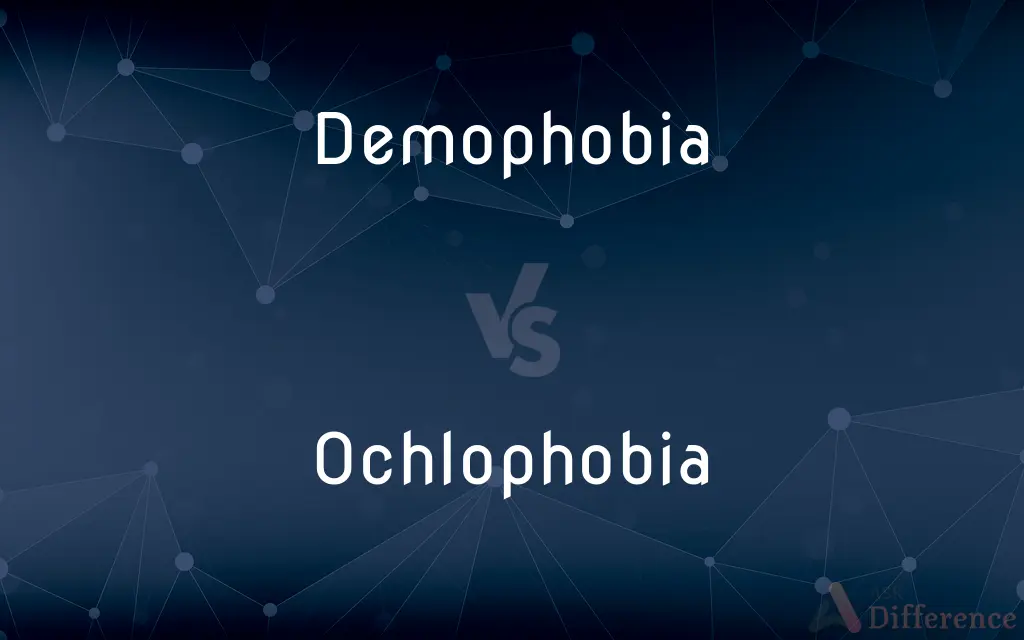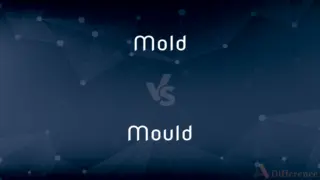Demophobia vs. Ochlophobia — What's the Difference?
By Fiza Rafique & Maham Liaqat — Updated on April 24, 2024
Demophobia focuses on the fear of crowds due to social aspects, while ochlophobia encompasses fear of any large gatherings, often driven by the potential for chaos.

Difference Between Demophobia and Ochlophobia
Table of Contents
ADVERTISEMENT
Key Differences
Demophobia is characterized by a fear specifically linked to being in crowded social situations, often due to the overwhelming nature of social interactions. Whereas ochlophobia includes a broader anxiety that stems from being in large groups of people, which could be due to various reasons such as fear of mob mentality or losing personal space.
People with demophobia may experience intense anxiety in social settings like parties or concerts, where the emphasis is on interaction and social engagement. On the other hand, individuals with ochlophobia might avoid any large gatherings, including non-social situations like public demonstrations or packed train stations, where the density and unpredictability of the crowd are the main concerns.
The root causes of demophobia often tie back to previous negative social experiences or underlying social anxiety disorders. Whereas, ochlophobia can be triggered by past traumatic experiences in large crowds where the individual felt endangered or excessively confined.
Treatment for demophobia typically includes cognitive behavioral therapy focusing on managing social anxiety and improving interpersonal comfort levels. On the other hand, therapy for ochlophobia might concentrate more on exposure strategies and coping mechanisms for dealing with large groups and chaotic environments.
In popular culture, demophobia is less frequently portrayed or discussed compared to ochlophobia, which is often depicted in scenarios involving mass panic or catastrophic events that lead to crowd chaos.
ADVERTISEMENT
Comparison Chart
Definition
Fear of crowds primarily due to social interaction aspects.
Fear of crowds, with emphasis on the chaos and lack of control.
Common Triggers
Social gatherings, parties, public speaking.
Large gatherings, public demonstrations, crowded transport.
Symptoms
Anxiety, avoidance of social interactions, panic attacks.
Anxiety, avoidance of any large groups, feeling of suffocation.
Treatment
Cognitive behavioral therapy, social skills training.
Exposure therapy, stress management techniques.
Cultural Representation
Less commonly discussed or portrayed.
Often depicted in scenarios involving mass panic or disasters.
Compare with Definitions
Demophobia
Intense fear of being in crowded social situations.
She avoids concerts due to her demophobia.
Ochlophobia
Fear of any large gatherings, irrespective of their nature.
His ochlophobia keeps him away from rallies and sports events.
Demophobia
Anxiety disorder focusing on the social component of crowds.
His demophobia makes office parties a daunting experience.
Ochlophobia
Avoidance behavior towards crowded places.
His ochlophobia dictates his travel plans to avoid peak seasons.
Demophobia
Need for solitude in social aspects of life.
Her demophobia influences her preference for online shopping.
Ochlophobia
Overwhelming distress about losing personal space in crowds.
She experiences severe ochlophobia in crowded elevators.
Demophobia
Avoidance of places known for social gatherings.
Due to her demophobia, she prefers quiet cafes over busy restaurants.
Ochlophobia
Coping strategies to manage crowd-induced anxiety.
She uses music to cope with her ochlophobia during commutes.
Demophobia
Panic attacks triggered by social interactions within crowds.
Crowded festivals trigger his demophobia severely.
Ochlophobia
Anxiety induced by the unpredictability of crowds.
Ochlophobia makes her anxious in any crowded setting, even at a park.
Demophobia
(rare) A phobia, or fear, of crowds, masses, or people.
Ochlophobia
Extreme or irrational fear or dislike of crowds.
Ochlophobia
Fear of crowds.
Ochlophobia
A phobia, or fear, of mob-like crowds, as opposed to simply open spaces like agoraphobia or large crowds as with enochlophobia.
Common Curiosities
What is demophobia?
Demophobia is the fear of crowds mainly due to social interaction aspects.
How do symptoms of demophobia and ochlophobia differ?
Demophobia symptoms are closely tied to social anxiety, whereas ochlophobia symptoms focus on a general fear of crowd-related chaos.
What are common triggers for demophobia?
Common triggers include social events, parties, and anywhere with dense social interactions.
What is ochlophobia?
Ochlophobia is the fear of any large gatherings, typically concerned with chaos and unpredictability.
Are children affected by demophobia or ochlophobia?
Yes, children can develop either condition, often due to traumatic crowd experiences or inherent anxieties.
Can demophobia and ochlophobia be cured?
While they can be managed effectively with therapy and coping strategies, they are not always completely curable.
How do demophobia and ochlophobia impact daily life?
They can significantly restrict where and how individuals travel, socialize, and participate in public life.
Can demophobia and ochlophobia occur simultaneously?
Yes, an individual can experience both demophobia and ochlophobia, each amplifying the anxiety triggered by crowds.
How is demophobia treated?
Treatment typically involves cognitive behavioral therapy and social skills training.
How do people with ochlophobia cope in crowded places?
They often avoid such places or use coping mechanisms like listening to music or focusing on calming thoughts.
Is there a genetic component to demophobia or ochlophobia?
While not specifically genetic, anxiety disorders, including these phobias, can run in families.
What are common triggers for ochlophobia?
Common triggers include any large gatherings, especially those perceived as chaotic or uncontrollable.
How is ochlophobia treated?
Treatment may include exposure therapy and learning coping strategies for managing stress in crowds.
How do people with demophobia cope in social situations?
They may use avoidance strategies, seek therapy, or rely on support from friends and family.
What should someone do if they think they have demophobia or ochlophobia?
Seeking advice from a mental health professional is recommended to assess the situation and discuss possible treatment options.
Share Your Discovery

Previous Comparison
Plot vs. Emplotment
Next Comparison
Mold vs. MouldAuthor Spotlight
Written by
Fiza RafiqueFiza Rafique is a skilled content writer at AskDifference.com, where she meticulously refines and enhances written pieces. Drawing from her vast editorial expertise, Fiza ensures clarity, accuracy, and precision in every article. Passionate about language, she continually seeks to elevate the quality of content for readers worldwide.
Co-written by
Maham Liaqat













































